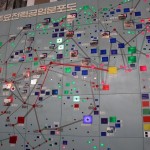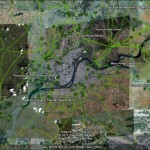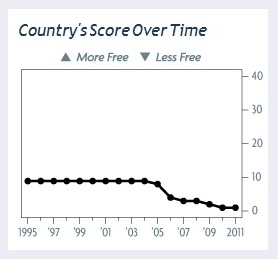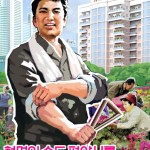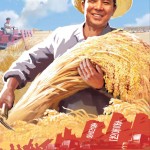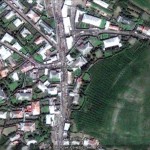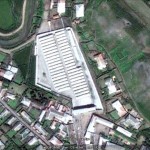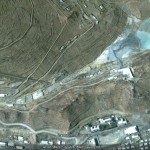According to Catholicculture.org (2011-9-23):
Religious leaders, including Catholic leaders, from democratic South Korea are visiting Communist North Korea, one of the world’s most repressive nations.
“The visit of a delegation of religious leaders in North Korea is a gesture to keep an open channel with the North,” says Bishop Peter Kang of Cheju, president of the bishops’ conference. “But we need to be realistic, and not have any great illusions. Religions will continue to bring humanitarian aid to the population of the North who suffer from hunger, and this is the interest of Pyongyang. Believers in the North are closely monitored and religious freedom is denied.”
Delegation itinerary:
According to KCNA, the delegation arrived in Pyongyang on Sept 21:
A south Korean delegation of 7 religious orders headed by Kim Hui Jung, representative chairman of the South Korean Religionists Council for Peace and head of the Kwangju Archdiocese of the Catholic Church, arrived here on Wednesday.
According to KCNA, the group held a meeting on the 22nd:
A meeting of north-south religionists for national reconciliation, unity and peaceful reunification took place in Pyongyang on Thursday.
Present at the meeting were Jang Jae On, chairman of the Religious Believers Council of Korea; Kang Yong Sop, chairman of the Central Committee of the Christian Federation of Korea; Sim Sang Jin, chairman of the Central Committee of the Buddhist Federation of Korea; Kang Chol Won, vice-chairman of the Central Guidance Committee of the Chondoist Association of Korea; and members of religious organizations.
Also attending it were members of the delegation of south Korea’s 7 religious orders led by Kim Hui Jung, representative chairman of the South Korean Religionists Council for Peace and head of the Kwangju Archdiocese of the Catholic Church.
Speakers at the meeting spoke of the pleasure of representatives of different religious organizations in the north and the south at sitting together and having their meeting for national reconciliation and unity and peaceful reunification.
They noted the meeting would mark a meaningful occasion in demonstrating internally and externally the strong will of the believers in the north and the south to tide over difficulties in the way of national reunification, promote national concord and bring about a new phase of peace and independent reunification.
They called upon believers in the north and the south to advance, holding higher the banner of “By the Korean nation itself” convinced that the implementation of the June 15 joint declaration leads to the reunification and peace of the country.
A joint statement of the believers in the north and the south for national reconciliation, unity and peaceful reunification was made public at the meeting.
The statement said that they would make positive efforts to defuse antagonism and distrust, tension and confrontation between compatriots, remove the danger of war and ensure durable peace.
It stressed the need to solve all the problems between the north and the south in conformity with the will and interests common to the nation.
It went on:
The Religious Believers Council of Korea in the north and the south Korean Religionists Council for Peace will regularly hold meetings to boost dialogue and cooperation between themselves and actively conduct a movement to achieve the unity of believers and reunification.
The statement ardently called upon all the Koreans in the north and the south and abroad to join as one in the drive for national reconciliation, unity, peace and reunification.
According to KCNA, following the meeting the delegation visited Mangyongdae, Mt. Paektu, the Arch of Triumph, the Taedonggang Combined Fruit Farm and its new processing factory, and saw “Arirang”.
On Sept24, the delegation departed.
Some history:
Around the time of the delegation’s visit, Kwang On-yoo sent out the following information to the Korean Studies list:
Just before the Korean War there were 52 Catholic parishes in the North, with some 50,000 believers in three dioceses, Pyongyang, Hamhung and Chunchon, plus a territorial abbey that was a direct subject of the Holy See.
After the end of the Korean War and the resulting division of the nation, the Vatican handed over the Apostolic administration of the North Korean dioceses to bishops in South Korea.
The current Archbishop of Seoul, Cardinal Cheong Jin-suk, is the Apostolic Administrator for Pyongyang and Hamhung while Bishop Kim Un-hwi of the Chunchon diocese in South Korea is the Apostolic Administrator of Chunchon diocese in North Korea.
Over the years, requests by the South Korean Bishops for pastoral visits to the North Korean dioceses have repeatedly been denied.
Since 1988, the North Korea regime has presented Jangchung ” Cathedral” [See satellite image here], the only so called Catholic church in North Korea, to outsiders as a shining example of North Korean Catholicism with hundreds of parishioners. Actually, the church has no functioning priest and no sacraments.
In April, a Seoul based North Korean defector’s radio station, Free North Korea, alleged that Jangchung Church is in fact a clandestine cocaine factory where cocaine is manufactured for illegal export, to generate much needed foreign currency.
This is the current state of North Korean Catholicism.
I do not have any reason to believe that the church is used to produce cocaine since it has been effective at generating revenue and assets from abroad (especially South Korea) through more “traditional” methods–such as facilitating the recent delegation.


